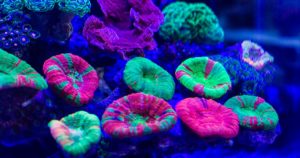I’m always searching for new ideas for my alien cultures. I hadn’t thought of glow-in-the-dark aliens until I stumbled across a piece by Marina Koren in the Science section of The Atlantic, published August 27l, 2019.
Two researchers, Lisa Kaltenegger and Jack O’Malley-James, astronomers at the Carl Sagan Institute at Cornell University, believe hunting for glowing aliens might provide new clues to life on planets subjected to high levels of ultra violet radiation. Ultra violet is deadly to many, but not all, organisms on earth. (photo from medium.com).
According to scientists who study them, corals in shallow waters have found a way to guard against the worst of the sun’s rays. Fluorescent pigments in the invertebrates absorb damaging ultraviolet light, transform it, and then emit it as harmless, visible light. The instantaneous change in the wavelength of the light, from long to short, produces a brilliant show of colors, from pinks and purples to greens and reds. (The process can protect single-celled organisms that live inside the coral and supply food in exchange for shelter.)
the invertebrates absorb damaging ultraviolet light, transform it, and then emit it as harmless, visible light. The instantaneous change in the wavelength of the light, from long to short, produces a brilliant show of colors, from pinks and purples to greens and reds. (The process can protect single-celled organisms that live inside the coral and supply food in exchange for shelter.)
“If such a strategy were beneficial for life on another world, it should be very likely for other life-forms to also evolve such a biofluorescent strategy,” says Kaltenegger, the director of the Sagan Institute. “If you and I would have evolved on such a world, we would probably glow, too.”
Proxima Centauri is one of our closest neighbors. It’s smaller, dimmer, and cooler than our sun, and has one planet, Proxima Centauri b, that orbits in the habitable zone, is about the same size as Earth, and might be rocky like it, too.
If Kaltenegger’s assumptions prove accurate, it could lend hope for life on other planets NASA has already identified in the habitable zone. A large fraction of exoplanets—planets beyond our solar system—reside in the habitable zone of M-type stars. This type of star, the most commonly found in the universe — frequently flare, and when those ultraviolet flares strike their planets, biofluorescence could paint these worlds in beautiful colors. (medium.com) On February 22, 2017, NASA announced that its Spitzer Space Telescope had observed a system of seven Earth-size planets around a single star, TRAPPIST-1. Three of the planets are located in what’s called the habitable, or “Goldilocks” zone, but all seven of the TRAPPIST-1 planetary orbits are closer to their host star than Mercury is to our sun.
 Unlike other extreme environments (see my blog of 3-30-20), biofluorescence is found in a number of higher life forms, including lizards, frogs. Recently, scientist discovered a biofluorescent Hawksbill Sea Turtle. (photo by National Geographic).
Unlike other extreme environments (see my blog of 3-30-20), biofluorescence is found in a number of higher life forms, including lizards, frogs. Recently, scientist discovered a biofluorescent Hawksbill Sea Turtle. (photo by National Geographic).
Jack O’Malley-James, a researcher at Cornell’s Carl Sagan Institute and the study’s lead author, says: “This is a completely novel way to search for life in the universe. Just imagine an alien world glowing softly in a powerful telescope.” (medium.com)
The idea of a planet, softly glowing in the inky black of space, certainly fires my imagination. How about you?
The idea of a planet, softly glowing in the inky black of space, certainly fires my imagination. How about yo
